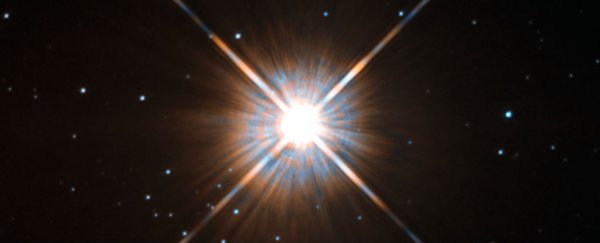Tomorrow, we might finally get some concrete details on one of the most tantalising astronomy rumours in recent memory - the possible discovery of a habitable planet orbiting our Sun's nearest neighbour, Proxima Centauri.
Just to give you an idea of how cool it'd be if confirmed, right now, the closest known, potentially habitable exoplanet is Wolf 1061c, and it's 14 light-years away. That's 126 trillion kilometres from Earth. Meanwhile, this rumoured planet is just 4.25 light-years away.
That relative proximity is what's gotten everyone so excited. The rumoured planet isn't off in the far-flung reaches of the Universe that we'll never see, it's located in Alpha Centauri - the closest star system to our own Solar System.
The Alpha Centauri star system is located 4.4 light-years away from our Sun in the constellation of Centauru. Discovered back in 1915, it's believed to consist of three stars: Alpha Centauri A; Alpha Centauri B; and Proxima Centauri, a small red dwarf, low-mass star.
This star system is so close - relatively - you can actually see Alpha Centauri A and Alpha Centauri B in the night sky. In fact, Alpha Centauri A is the fourth-brightest star seen from Earth.
Proxima Centauri is the closest star to our Sun, at about 4.25 light-years away. It's too small for us to see when we're star-gazing, but it might be hiding the best secret of all.
It's believed that a new 'mystery planet' is orbiting Proxima Centauri, and not only does it appear to have a rocky surface, it's the right distance from its star to sustain liquid water - two key factors for a potentially habitable planet.
To be clear, we only know about this potential discovery thanks to what appears to be leaked reports from anonymous researchers at the European Southern Observatory (ESO), and the only news outlet that purports to know much of anything about this is German weekly magazine, Der Spiegel.
"The still nameless planet is believed to be Earth-like and orbits at a distance to Proxima Centauri that could allow it to have liquid water on its surface - an important requirement for the emergence of life," the magazine reported on August 12. "Never before have scientists discovered a second Earth that is so close by."
The ESO has been studying Proxima Centauri for years, using the La Silla Observatory's High Accuracy Radial velocity Planet Searcher (HARPS).
As Matt Williams from University Today explains, this is the same observatory that reported the discovery of a planet around Alpha Centauri B back in 2012, which they called the "closest planet to Earth" at the time - a claim that's since been cast into doubt.
Now we might be ready for round two.
When contacted by AFP, ESO spokesman Richard Hook denied knowing anything about the Der Spiegel report, and refused to confirm or deny any of the potentially leaked information. "We are not making any comment," he said.
But, as Der Spiegel predicted, ESO is making an announcement to the press in Germany tomorrow, and while it's said nothing about the topic of discussion, experts think it's likely it will finally be ready to address the rumours.
"The discovery of [a] possible planet around Proxima Centauri is very exciting," astronomer Phillip Lubin from University of California, Santa Barbara, who is not involved in the ESO research, told Universe Today.
"It makes the case of visiting nearby stellar systems even more compelling, though we know there are many exoplanets around other nearby stars and it is very likely that the Alpha Centauri system will also have planets."
So what happens if they confirm the existence of a potentially habitable planet 4.25 light-years from Earth?
At 39,900,000,000,000 km away from Earth, or 271,000 times the distance from Earth to the Sun, we're not going to be visiting it any time soon, but it's close enough for us to actually study it, unlike those Earth-like planet candidates from NASA's Kepler mission, some of which are hundreds of light-years away.
The ESO press conference will start 1 pm Central European Time (CET), or 7 am EDT, 4 am PDT, 9pm AEST.
Update: We've been informed that information from the press conference is embargoed until 12pm UT, so check back at ScienceAlert then!
